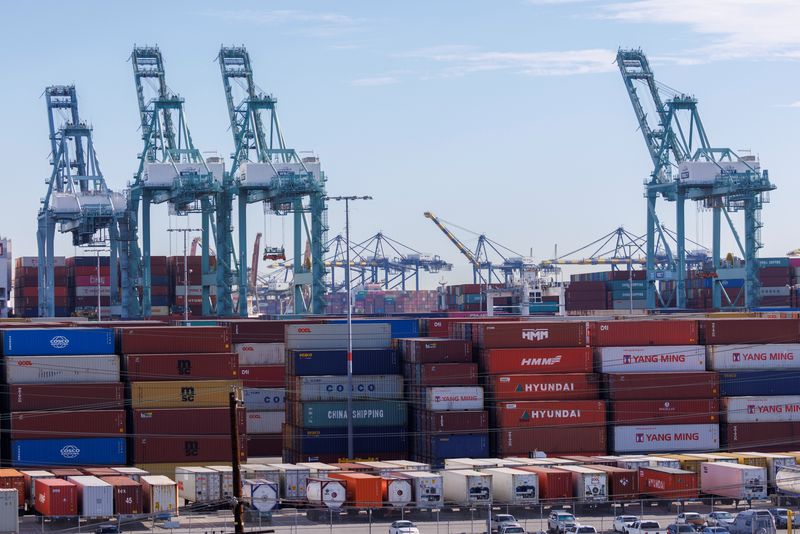By Lucia Mutikani
WASHINGTON (Reuters) - The U.S. trade deficit in goods narrowed in February, but the fall reversed only a fraction of the surge to a record high in January, suggesting that trade would again weigh on economic growth in the first quarter.
Though the advance indicators report from the Commerce Department on Monday showed businesses continuing to restock last month, the pace slowed from late 2021, implying that there would probably be no contribution to gross domestic product growth from inventory investment either.
"We think trade might subtract about two-three percentage points from GDP growth in the first quarter," said Daniel Silver, an economist at JPMorgan (NYSE:JPM) in New York. "While it looks likely to us that the real change in inventories will be strong again, it may end up comparable to the large increase reported for the fourth quarter and therefore inventories could be fairly close to a neutral factor for GDP growth in first quarter."
The trade deficit last month fell 0.9% to $106.6 billion, the Commerce Department said on Monday. The goods trade deficit hit an all-time high of $107.6 billion in January.
Exports increased 1.2% to $157.2 billion. Economists believe exports, which were not adjusted for inflation, were flattered by higher prices rather than increased volumes. A blockade of U.S-Canada border crossings by Canadian truck drivers last month likely reduced export volumes.
The government will publish February's comprehensive trade report, which will include country data, next Tuesday.
Last month's rise in goods exports was led by a 6.3% surge in shipments of consumer goods. Food exports accelerated 3.6%, while industrial supplies increased 2.6%. But motor vehicle exports dropped 3.4% as production continued to be hampered by a global semiconductor shortage. There were also substantial declines in exports of capital goods and other goods.
IMPORT GROWTH MODERATES
Imports of goods gained 0.3% to $263.7 billion. They were curbed by a 9.9% decline in imports of motor vehicles as well as a 3.0% drop in food imports. But there were strong increases in imports of industrial supplies and other goods.
Capital goods imports also rose as did consumer goods, pointing to strong business and consumer spending. Trade has subtracted from gross domestic product growth for six straight quarters. A shift in spending from services to goods during the COVID-19 pandemic led to a boom in imports as domestic manufacturers struggled with snarled supply chains.
A resurgence in coronavirus infections in China and Russia's war against Ukraine could worsen supply constraints.
"The strong economic recovery in the U.S. from the pandemic has supported imports while a relatively slower global economic recovery has weighed on exports," said Abbey Omodunbi, a senior economist at PNC Financial (NYSE:PNC) in Pittsburgh, Pennsylvania.
"The goods trade outlook is cloudy. New lockdowns in Shanghai and increased uncertainties from the Russia-Ukraine crisis will weigh on U.S. exports."
Businesses continued to replenish inventories in February, though the pace was less frantic than towards the end of last year. Wholesale stocks increased 2.1% after climbing 1.1% in January. Retail inventories rose 1.1% in February following a 1.9% advance in January.
Motor vehicle inventories gained 0.9% after surging 2.5% in January. Excluding motor vehicles, retail inventories increased 1.2% after accelerating 1.7% in January. This component goes into the calculation of GDP growth.
Inventory investment accelerated at a robust seasonally adjusted annualized rate of $171.2 billion in the fourth quarter, contributing 4.90 percentage points to the quarter's 7.0% growth pace.
Despite February's solid rise, inventories are likely to be neutral to GDP growth this quarter as they would need to increase at a faster rate than in the fourth quarter to contribute to growth. First-quarter GDP growth estimates are mostly below a 1.0% pace.

Some economists believe the pace of inventory investment is sufficient to contribute to GDP growth this year.
"These strong levels are broadly consistent with our view that inventory investment will provide solid support for GDP this year, with inventories remaining very low in relation to sales after having been pared in earlier stages of the pandemic," said Jonathan Millar, an economist at Barclays (LON:BARC) in New York.
